Ceramic bathroom tiles: how to choose and care for them?

Ceramic bathroom tiles allow you to create unlimited interior design variations. Modern manufacturers offer textured and smooth, matte and glossy finishes in a wide variety of styles. Tiles for walls and floors have long been learned to turn into a semblance of marble or natural wood, decorate with concrete, brick and metal.
Ceramic tiles for the bathroom are finishing materials, which are subject to rather strict requirements in terms of quality and reliability. To make the right choice, to ensure the durability and functionality of the coating, you will have to study all the features of such a decor in more detail.

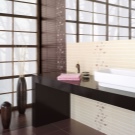
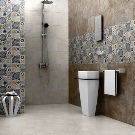
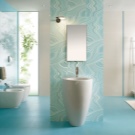
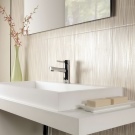
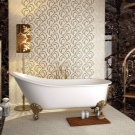
Advantages and disadvantages
Ceramic tiles for the bathroom are a material that is practically devoid of flaws. Among its obvious advantages are:
- a wide range of colors, textures, coating options;
- resistance to humid environment;
- high environmental friendliness of the material, it is non-toxic, completely safe to use;
- long service life;
- high aesthetic characteristics;
- preservation of the brightness of paints, surface properties;
- chemical neutrality;
- resistance to dirt formation;
- mechanical strength;
- ease of care and maintaining hygienic safety;
- unlimited possibilities for creating original interior solutions.
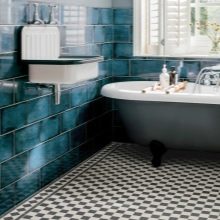
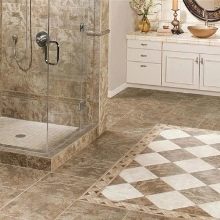

There are not so many disadvantages of ceramics intended for the bathroom, and the disadvantages are associated solely with the quality of work. Not every master is able to correctly, evenly and beautifully lay a mosaic covering or decorative panel.
Independent work in the absence of experience can lead to completely unpredictable results. The quality of grouting is also important: if mineral-based compounds are chosen, over time, the areas between the tiles will begin to look not very aesthetically pleasing.

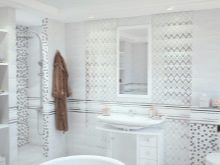

Decoding of marking
On the back surface of the tile or on its factory packaging, in accordance with the standards in force in Russia, there must be a marking indicating the operational properties of the product. To decipher it correctly, you need to know the established standards. Certain symbols are the most common.
- PEI. This abbreviation indicates the abrasion class of products. PEI I is only suitable for walls. If the number is from II to IV, we are talking about flooring or materials with a higher level of abrasion resistance.
- The image of an airplane, a medical cross, Olympic symbols, a bed. Indicates recommendations for the application of materials to specific sites. For example, for hospitals there is a tile that can be washed with chlorine-containing compounds. In airports, the vibration resistance of the pavement is important.
- Latin designation of chemical elements - Au, Ag, Pt. These icons indicate that the tiles contain gold, silver, platinum.
- Snowflake... It indicates that the material is resistant to frost. Relevant if the bath is located in a building with seasonal use.
- Image of a faceted diamond. Determines the hardness of the material.
- Black rectangle with a palm on it... All wall tiles are marked with it. The image of the footprint indicates the flooring of the cover.
- Image of a flask on a black background. It indicates the increased chemical resistance of the material.
These are the most common options, the meaning of other specific designations can always be checked with the sellers.

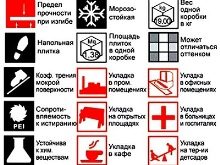
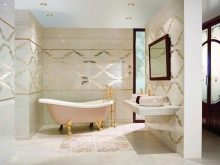
Dimensions (edit)
Standard range of tile sizes for bathroom use allows you to divide all products into specific formats.
- Big. This includes rectangular modules 20x50 cm, 25x40 cm, 20x30 cm, square 25x25 and 30x30 cm. They are used mainly for finishing the floor or accent wall, allowing you to minimize the number of seams.
- Average. It includes all square tiles with a side size of 20, 15, 10 cm. It is convenient in laying and calculating, it is in the medium format that most of the decorative coatings are most often produced.
- Small... Here you can distinguish 6x6 cm tiles, as well as mosaic elements. They are optimal for wall decoration that does not differ in ideal geometry. Small format allows you to hide small flaws and defects in the repair.



Manufacturers rating
Among the manufacturers of ceramic tiles for bathrooms especially popular brands can be noted.
- Lafabbrica. Italian quality tiles in the most incredible colors and solutions are produced by a manufacturer known far beyond Europe. Regular release of new collections, its own design bureau allow the brand to remain among the leaders in the industry.

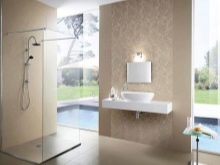
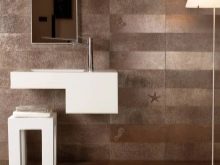
- Kerama Marazzi. The Russian-Italian joint venture has been successfully operating for over 27 years. Among the 200 products you can find economy class floor and wall coverings. The company has lines for interiors in Japanese, French, English, Scandinavian, Indian styles.
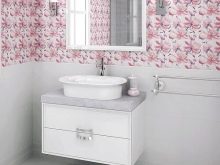

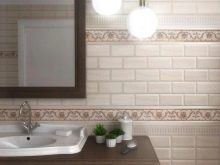
- Lasselsberger Ceramics. Austrian company with factories throughout Europe. In the Russian Federation, its own enterprise was opened in Bashkiria in 2006. Among the company's product range, the series of flooring "Rustic", "Perfect" and the collection "Parisienne" with a laconic glossy surface for finishing bathroom walls stand out.
The tiles are one of the best in terms of quality, are inexpensive and look stylish.
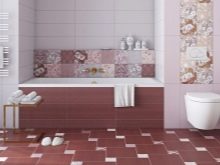
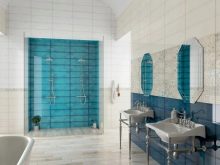
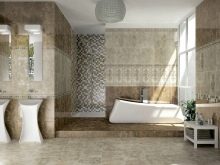
- Cersanit. A brand from Poland that produces high-quality and inexpensive bathroom tiles.The company's designer collections with floral and watercolor prints, as well as lines with abstract and ethnic ornaments are especially highly valued.
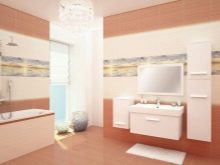

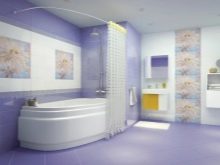
- Azori. A domestic company that pays great attention to the design of its products. In its assortment there are many bright collections with photo prints, the company follows fashion trends, strives to implement them in the lines of its tiles. High quality is combined with an affordable price of finishing materials.
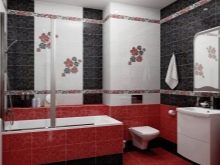

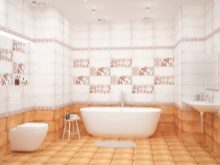
- Vivo. The Chinese company, one of the best in the world in the production of textured decorative tiles. The company has its own clay quarries for the extraction of raw materials, using its red varieties, achieving excellent durability of the finished product. China is a country with ancient traditions. And in the Vivo collections you can find interesting, unique elements of ethnic design.
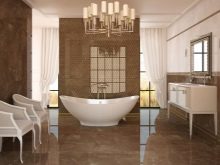
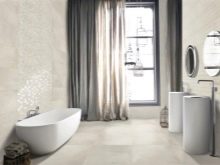
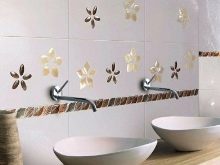
- Keramin. Belarusian manufacturer with budget prices and a wide range of products. The company has established a joint production with Italians, thanks to which the products have a modern design and meet European standards. The company specializes in the production of glossy monochromatic tiles in various formats.



Design options
Modern design projects allow you to decorate the interior in almost any stylistic direction. What decor is relevant for the bathroom today? What is good about the eternal classics, are sakura obligatory for the Japanese style, and landscapes with butterflies for ethno?
You can decorate the room in the English style - austere and laconic, or in the American country theme, add lightness of Provence or Baroque chic to it.
To make the right choice, it will be useful to familiarize yourself with fashionable novelties, find out what is trending among designers today.
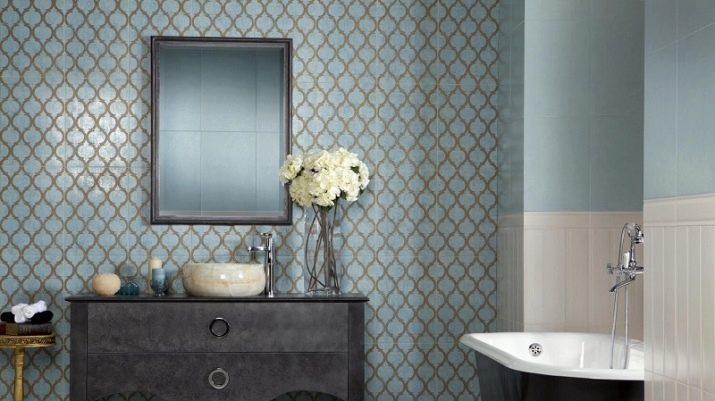
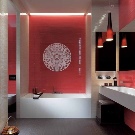
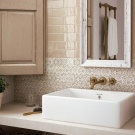
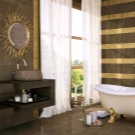
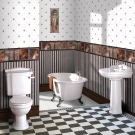
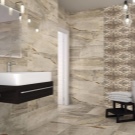
Bright tones
Modern tile manufacturers offer the widest range of colors to their customers. Here you can easily find all the colors of the rainbow, and it is advised to combine them as boldly as possible. Blue and yellow, pink and purple, green and orange tones create a special mood even in a small bathroom.
If you want to be in trend, you should choose all shades of citrus: lemon, lime, orange, they can be combined with neutral white, juicy light green or scarlet.
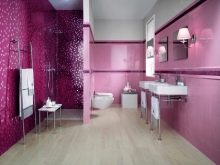
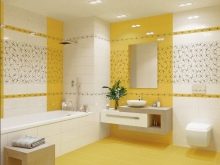

Tile "metro"
Small monochromatic tiles "like a brick", similar to the one that adorns the lobbies of the Parisian metro, in Russia is most often disrespectfully referred to as "boar". But this does not at all prevent her from being at the height of fashion.
The correct geometric elements with a pronounced relief look neat and orderly, they can be laid with a herringbone or classic brick. In bright red or blue, it looks good in small spaces. Neutral white, gray and black are best left to large to medium sized bathrooms.
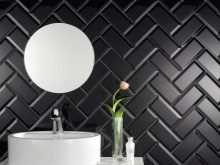

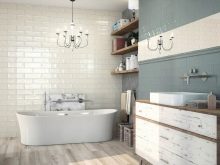
Antiquity
Marble tiles are perfect for wall and floor decoration. You can arrange the whole room in one color or choose contrasting shades. The noble pattern of natural stone looks luxurious and presentable. But such a finish is best combined with spacious rooms, where such decor looks appropriate and stylish.

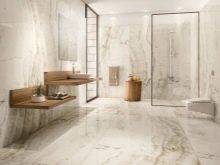

Mosaic
With the help of a mosaic, it is better to highlight part of the space: the area around the mirror, the shower room, the floor. A solid mosaic panel on all surfaces looks too colorful. Such decor looks interesting in combination with metal horizontal or vertical elements, framing the ledges with tiles imitating natural stone.

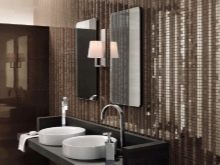
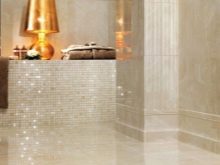
Geometry
Intricate geometric patterns that violate all rules and laws are what designers consider fashionable. Tiles of different sizes and colors laid diagonally or in broken lines look very bright, unusual and stylish.
You just need to choose the right option for such an avant-garde finish. For example, gray honeycomb tiles are popular in Scandinavian designs, while bright purple or purple rhombuses on the walls are perfect for Provence or Rococo.
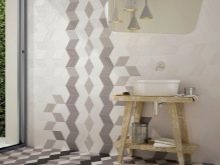

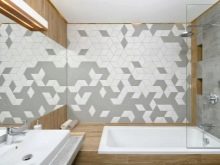
Ethnic
Patchwork tiles or Egyptian hieroglyphs, imitation of rough stone and natural fabric. All this allows the decoration of the bathroom with ceramics in ethnic or country style. Options for Gzhel or other types of traditional art will also come in handy.
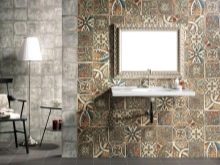
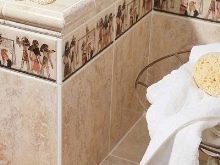
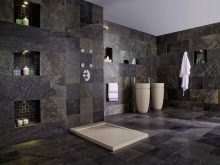
Watercolor
Light, slightly blurred watercolor drawings are what works well for decorating a bathroom in a romantic, delicate style. Japanese sakura in bloom, a suburb landscape or a reproduction of a famous painting. All this can be brought into the bathroom design. True, large-format panels should be used in spacious rooms.
In a small bathroom, a few decorative inserts on a plain background will be enough.
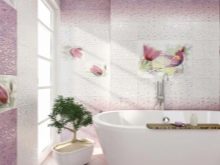
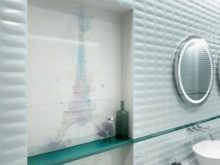

How to choose?
Choosing a bathroom tile is a very important decision. The chosen wall and floor finish will not be as easy to change as wallpaper or paint. In addition, the tiles must meet a number of requirements related to the characteristics of the indoor microclimate. What should you pay attention to first of all? It is worth remembering the most important selection criteria.
- Appointment of the premises. If it is a bathroom in a residential building or in an apartment, there is no need to overpay for a high class of mechanical strength. The increased abrasion of the coating will not be threatened anyway. Only the toughest tiles should be installed in a hotel apartment or hospital sanitary block, which can easily withstand frequent washing and cleaning.
- Place for installation. Floor coverings radically differ from wall coverings in their characteristics, dimensions, and the degree of roughness. If you do not take into account all these points, you can face serious problems during the operation of the product.
- Surface area. The more spacious the room, the larger the elements in its decoration can be. For small-sized housing, where the bathroom is often very cramped, it is better to select mosaic coverings with small fragments.
- Color spectrum. It can be neutral, bright or monochrome. The presence of natural light or well-organized artificial lighting allows for dark tones to be chosen. Colorful ethnic patterns visually deepen the space, create the illusion of greater space. It is better to leave large, complex, subject panels for spacious baths.
- Material type. Porcelain stoneware is more durable, with its help functional areas are usually trimmed. Ceramics or tiles require more careful handling.
- Edge processing. Rectified tiles are suitable for installation with a minimum gap - the seam will be invisible. It is this method of edge processing that is used by the world's leading manufacturers.
- Laying method. For independent work, it is not recommended to choose complex or mixed-sized compositions. It is better to entrust expensive panels and decorative coatings to professionals.
- The form... There are rectangular, square, polygonal tiles. Docking with each other in the bathroom is easier with options with a simple form.
- Tile options. For walls, you should not choose modules thicker than 6-9 mm; glazed, glossy coatings are more suitable for the bathroom. For the floor, medium-sized tiles with a thickness of 9-12 mm are suitable, the tiles should be low-porous.
These are the basic guidelines to consider when choosing high quality, modern and durable tiles for your bathroom.
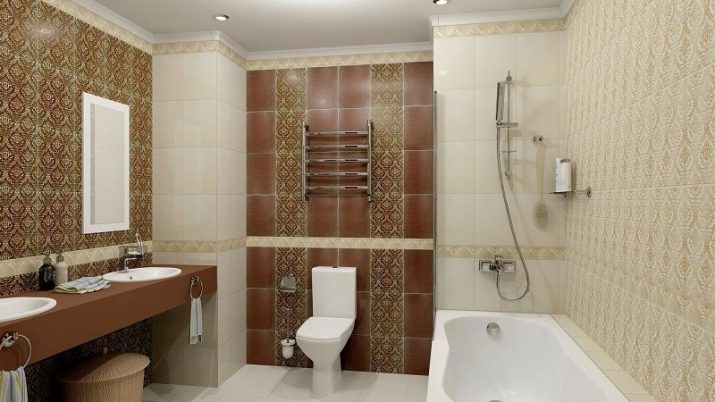
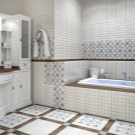
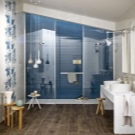


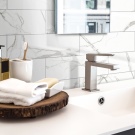
Care Tips
In order for ceramic tiles in the interior of the bathroom to retain their attractiveness for a long time, they need proper and thorough care. In its absence, a humid environment, combined with not very good ventilation, can turn the room into a source of bacteriological danger. There are several rules that should be followed.
- Avoiding abrasive products and harsh tools. Despite the rather high mechanical strength, the surface that regularly comes into contact with hard sponges or mineral-based compounds will lose shine and gloss faster, and will be covered with scratches.
- Ban on chlorine and chlorine-containing compounds. This is due to the fact that it is impossible to predict a possible change in the color of the coating upon contact with a caustic chemical. That is, the tiles can either retain their previous shades or become stained or completely change color.
- Sponges and napkins as tools. One should have a harder and more dense coating on the back. The second will be soft. You will need microfiber cloths for shine.
- Liquid detergents selected based on goals and objectives. Fat deposits work well with dishwashing detergents. Baking soda or soda ash will wipe off tough dirt. Spray products are suitable for removing limescale and other specific deposits.
- Regular cleaning... It must be performed at least once every 10 days or as it gets dirty. It is recommended to cover the seams and the coating with protective compounds every 6 months.
- Elimination of condensation formation. Moisture from the surface of the tiles should be wiped off immediately after taking a shower or bath; to avoid the appearance of mold and mildew, improving the ventilation of the room, installing air dehumidifiers will help.
By following these guidelines, you can provide your bathroom tiles with a truly long life and maintain their attractiveness for years to come.
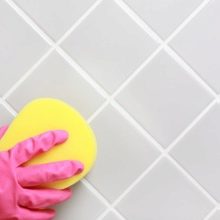

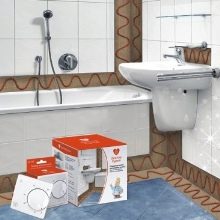
For information on how to choose the right ceramic tiles for the bathroom, see the next video.








